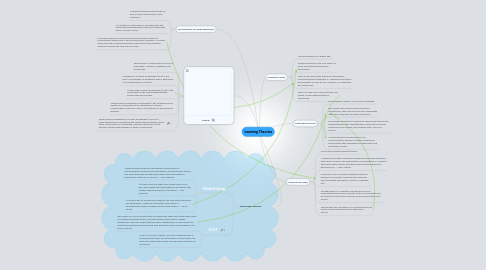Learning Theories
por Anna Bado

1. Technology Theories
1.1. Media Ecology
1.1.1. “Media ecology looks into the matter of how media of communication affect human perception, understanding, feeling, and value; and how our interaction with media facilitates or impedes our chances of survival.” – Neil Postman
1.1.2. "It tries to find out what roles media force us to play, how media structure what we are seeing, why media make us feel and act as we do." – Neil Postman
1.1.3. "It is the study of media environments, the idea that technology and techniques, modes of information and codes of communication play a leading role in human affairs." – Lance Strate
1.2. SCOT
1.2.1. Advocates of Social Construction of Technology argue that technology does not determine human action, but that rather, human action shapes technology. They also argue that the ways a technology is used cannot be understood without understanding how that technology is embedded in its social context.
1.2.2. SCOT is not only a theory, but also a methodology: it formalizes the steps and principles to follow when one wants to analyze the causes of technological failures or successes.
2. TPACK
2.1. The interplay of three primary forms of knowledge: Content, Pedagogy, and Technology.
2.2. Pedagogical Content Knowledge (PCK) is the idea of knowledge of pedagogy that is applicable to teaching specific content.
2.3. Technology Content Knowledge (TCK) is the knowledge of the relationship between technology and content.
2.4. Technological Pedagogical Knowledge (TPK) emphasizes the existence, components and capabilities of various technologies as they are used in the settings of teaching and learning.
2.5. Technological Pedagogical Content Knowledge (TPACK) is understanding and negotiating the relationships between these three components of knowledge. Requires sensitivity to the dynamic relationship between all three components.
3. PHILOSOPHY OF TEACHNOLOGY
3.1. A teacher’s personal philosophy on how to utilize technology in the classroom.
3.2. An update on Philosophy of Teaching with the added acknowledgement of the role technology plays in today’s world.
3.3. A common trend is a focus put upon the student’s ability to communicate effectively in various electronic mediums. A modern understanding of writing and how to respond to the changing mediums in which we now learn to write.
4. CONSTRUCTIVISM
4.1. We are active creators in our own knowledge.
4.2. The central idea is that human learning is constructed, that learners build new knowledge upon the foundation of previous learning.
4.3. Encourages students to constantly assess how the activity is helping them gain understanding. With a well-planned classroom environment, the students learn HOW TO LEARN.
4.4. Constructivism promotes social and communication skills by creating a classroom environment that emphasizes collaboration and exchange of ideas.
5. CONNECTIVISM
5.1. Learning theory for a digital age.
5.2. Knowing where to find information is more important than knowing information.
5.3. Many of the processes previously handled by learning theories (especially in cognitive information processing) can now be off-loaded to, or supported by, technology.
5.4. Takes its cues from Constructivism but allows for the added benefit of technology.
6. COGNITIVE LOAD
6.1. Instructional design learning theory.
6.2. "Cognitive load theory has been designed to provide guidelines intended to assist in the presentation of information in a manner that encourages learner activities that optimize intellectual performance". – John Sweller
6.3. Instruction may be aimed at teaching learners problem solving skills, thinking and reasoning skills (including perception, memory, language, etc.)
6.4. Another aspect of cognitive load theory involves understanding how many discrete units of information can be retained in short-term memory before information loss occurs.
6.5. Appreciates the foundation of Constructivism but offers a measured approach to teaching a learner.

